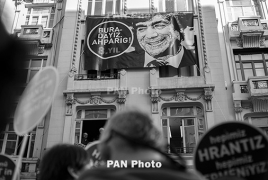
Public Radio International (PRI) has unveiled an article about the Armenians in Turkey who revive their identity more than 100 years after the Genocide of 1915.
For decades, Armenians in Turkey who survived a genocide committed by Turkey’s predecessor state — the Ottoman Empire — remained largely underground.
A turning point came for underground Armenians when, in 1996, Turkish Armenian journalist Hrant Dink founded a newspaper called Agos. The paper, published in both Turkish and Armenian, was the first Armenian-language newspaper in the Republic of Turkey’s history.
Agos’ office, located in an unassuming high-rise in Istanbul’s Şişli district, boasts its epic history of Armenian heritage: flowing runes of the Armenian script abound — a rare sight in the Bosporus city.
“Before Agos, the situation of Armenians in Turkey was almost unknown,” says Pakrat Estukyan, a veteran journalist with the paper, as he finishes his first of many cigarettes during the interview. “When we started, no one knew how many Armenians were in Turkey.”
The paper aims to educate Turkish society about its still-extant Armenian element, including Turkish Armenians. “Many Turkish Armenians can’t read the [Armenian] alphabet,” Estukyan says, explaining that the decision to publish in two languages was as much for Istanbul’s Armenian community as it was for Turks themselves.
As the paper’s stature grew, so did the attention — and not all was positive.
“We first started getting threats when Hrant began publishing excerpts from Raymond Kevorkian’s [a French Armenian historian] book, discussing the Armenian heritage of cities like Van, Mush, Diyarbekir,” Estukyan says. The cities named, all in the far eastern part of Turkey known as Anatolia (previously known as Western Armenia), each had a large Armenian population until 1915.
Dink was prosecuted three times under Article 301 of the Turkish penal code for “denigrating Turkishness.” The largest escalation came in 2004 when Dink released an article claiming Sabiha Gokcen, Turkey’s first female fighter pilot and the adopted daughter of Mustafa Kemal Ataturk, the founder of Turkey, had Armenian heritage.
Dink was shot dead by a Turkish nationalist near his paper’s office on Jan. 19, 2007.
Dink’s assassination, and the 100,000-strong march in support of him and Turkish Armenians in the aftermath provided the immediate momentum for Armenians to reveal their concealed identities in the long-cleansed villages of eastern Turkey.
By 2015 — the centenary of the Armenian genocide — Turkey’s general elections featured three openly ethnic Armenian candidates to Turkey’s parliament for the first time in history.
Selina Dogan was one of them.
A lawyer by trade, she was the leading candidate on the opposition party CHP’s electoral list for the second of Istanbul’s three electoral districts. The moment was “instrumental,” she wrote in an email to The World. “The problems of not only the Armenians but all [of Turkey’s] minority communities became more visible ... in the public sphere.”

